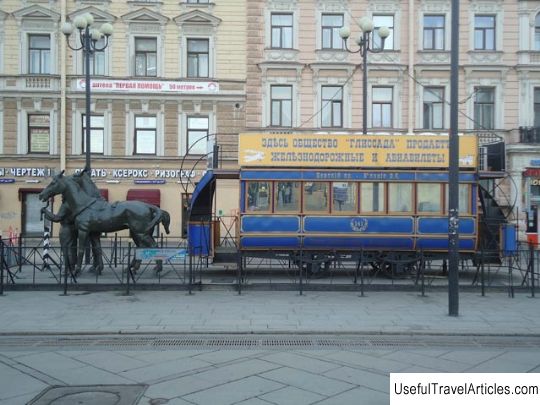Horse tram monument description and photo - Russia - St. Petersburg: St. Petersburg
Rating: 8,1/10 (4850 votes) 
Horse trail monument description and photos - Russia - Saint Petersburg: Saint Petersburg. Detailed information about the attraction. Description, photos and a map showing the nearest significant objects. Photo and descriptionAt the beginning of the 20th century, before the massive use of electricity, horse trams (horse-drawn railways) were the main means of transporting a large amount of cargo and a large number of passengers in St. Petersburg - as a rule, representatives of the poor population without funds for cabs. Konka is one of the types of omnibus (one- or two-story carriage, harnessed by one or two horses). The horse car speed was about 8 km per hour. Double-decker cars had an open upper platform (imperial), which could be climbed by a metal spiral staircase. The platforms differed in the arrangement of the benches - at the bottom, the benches were located, as in modern trams, on the imperial, the passengers had to sit with their backs to each other on one long double-sided bench. A ticket on the first "floor" cost 5 kopecks, it could accommodate 22 people, on the imperial - 24 people paid 2 kopecks for travel. At the beginning of the XX century, the horse tram covered 30 routes passing through the center, Admiralteyskaya Square, Nevsky Prospect and Sadovaya Street. The profitability of the horse tram turned out to be enormous - when the first line was launched in the city, in the first year alone it transported about a million passengers. Therefore, a specialized society was created, which owned six equestrian parks for 3.5 thousand horses, which served 26 routes with a total length of about 150 km. The horse-drawn carriage was driven by a coachman, and the tickets were sold, the signals for stops and departures were given by the conductor. Driving the horse tram required a lot of skill and effort: when going down the bridge, even the slightest mistake was enough so that a heavy carriage could immediately hit the horses and provoke an accident. If there were steep ascents on the route, then additional horses were harnessed, driven by their coachman. After the ascent ended, the horses were unharnessed, and they remained to wait for the next show jumping, which they helped on a difficult section of the path. At the final stop, the horses were harnessed from the other end of the car, outweighed the bell with a brake and set off on the return voyage. The rails of the skates were imperfect, there were no grooves for the wheels, and the track was paved with cobblestones, laid on the level with the rails ... When the wheels jumped off the track, as well as when cornering, the horse carriage went straight over the stones, which caused very uncomfortable sensations among passengers. With the introduction of electric trams (1907), the St. Petersburg horse tram began to lose its significance and by 1917 it had completely disappeared. The monument to a truly popular means of transportation - the horse tram - was installed in 2004 opposite the Vasileostrovskaya metro station ... Vasilievsky Island is rightfully considered a primordial `` tramway '' the center of St. Petersburg, since it was there that the largest number of horse trail routes were laid. The monument - a two-story horse tram car - was created according to the model of 1872-1878. Details had to be restored according to the drawings of the Putilov plant, which were found in the Central Archives. A point of sale of tickets for trains and planes was placed in the trailer. In 2005, the monument was supplemented with new "characters" - sculptures of two horses by A. Ziyakaev, made of plastic and concrete. In 2009, a coachman-driver appeared by the sculptor I. Penteshin and co-authors. The coachman's clothes include historically accurate details: a cap, inscriptions, a badge with the number 1, the coat of arms of a horse-drawn railway - everything was recreated from historical photographs, Lenfilm records and archival materials. Even the buttons of the coachman's frock coat, with the coat of arms of Russia, were made from casts from the buttons of the original uniform of the coachmen, preserved at the Mosfilm studio.           We also recommend reading House of Adamini description and photo - Russia - Saint Petersburg: Saint Petersburg Topic: Horse tram monument description and photo - Russia - St. Petersburg: St. Petersburg. |




